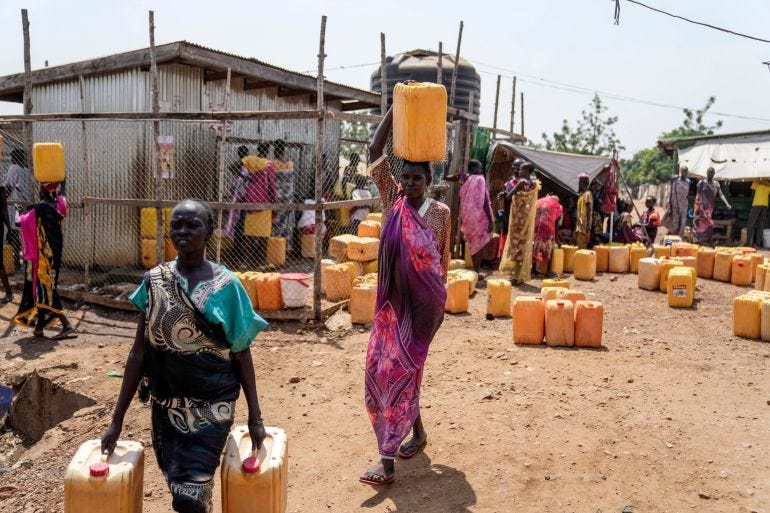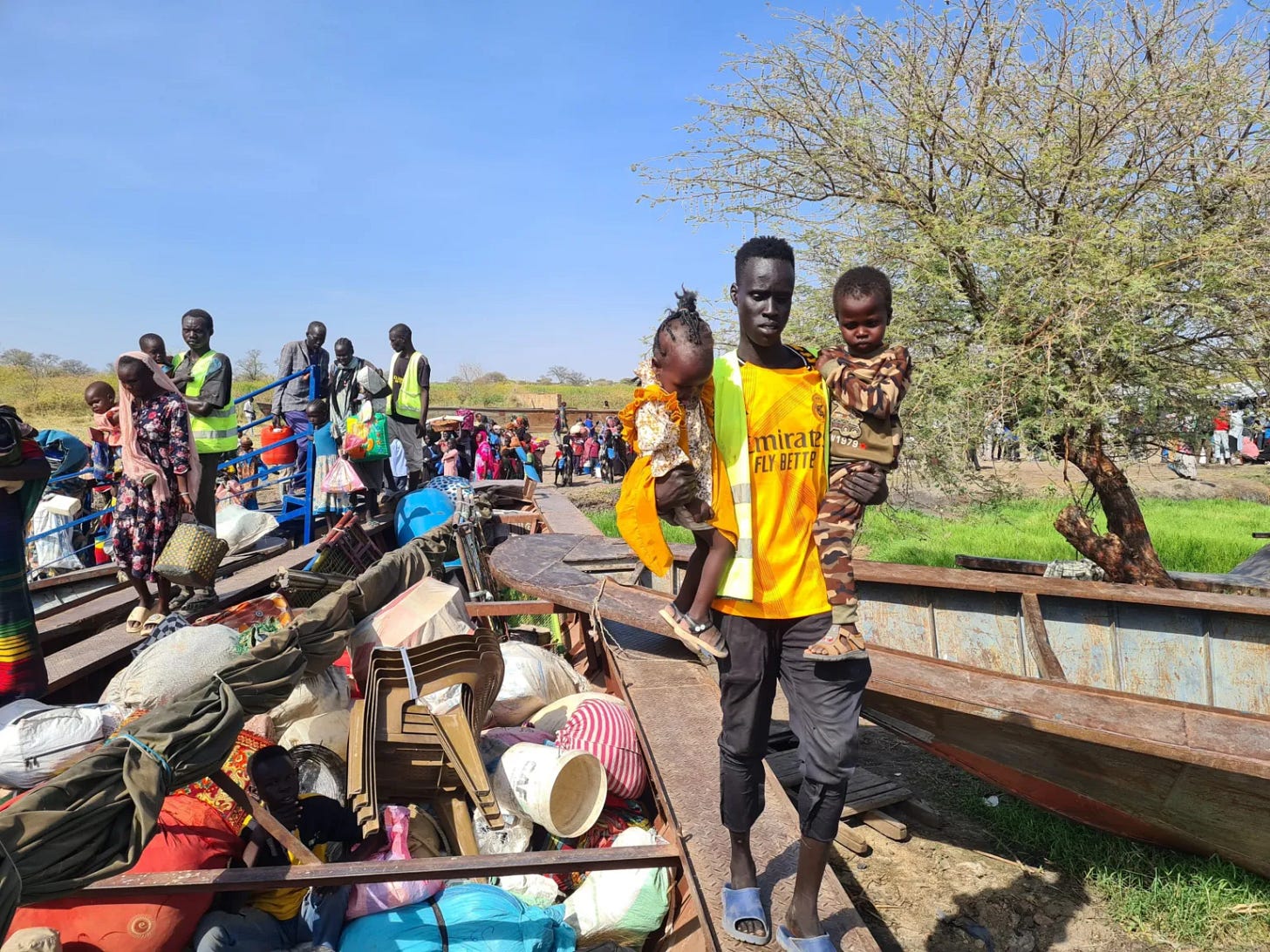South Sudan Hurtles Back Into Civil War
Ethnic Profiling and Attacks on Hospitals Will Have Disastrous Consequences
Attack helicopters bombed the only functional hospital in Fangak county in South Sudan’s Jonglei State on 3 May, leaving “a catchment of over 100,000 people” with no access to critical medical care, according to the UN Office for the Coordination of Humanitarian Affairs (OCHA).
“The pharmacy was destroyed. All medical supplies lost,” said Doctors Without Borders (MSF), which has been operating this facility since 2014.
The attack on the only hospital in the county—where people are already reeling under floods, food shortages, and disease amid continued fighting as South Sudan hurtles back into civil war—will have disastrous consequences.
“Women and girls will have their access to essential health services limited, including maternal, sexual, and reproductive healthcare. Critically, response services for survivors of rape and sexual violence have been suspended,” decried OCHA’s statement on Sunday.
This critical medical facility was “clearly marked as ‘hospital’ with our logo,” MSF’s head of mission in South Sudan, Mamman Mustapha told the BBC. “We have also shared our coordinates for all the warring parties in the area so the hospital should be known to both parties as a hospital.” He told the AFP, “I don’t think it was an accident.”
MSF has not identified the attackers, but local eyewitnesses and County Commissioner Biel Boutros Biel said the aircraft “belonged to the government”.
Fangak is among the nine counties the government, loyal to President Salva Kiir, has classified as “hostile”, amid an intensifying conflict with the armed opposition loyal to the First Vice-President Riek Machar, threatening to hurl South Sudan back into civil war.

Decades old power struggle
Both Kiir and Machar were senior commanders in the Sudan People’s Liberation Army (SPLA), the armed wing of the Sudan People’s Liberation Movement (SPLM). Seceding from Sudan after fighting a civil war for over two decades under the leadership of John Garang, the SPLM formed the Republic of South Sudan in 2011, with Kiir as its president, and Machar as the vice president.
However, the top leaders of the youngest country in the world already had bad blood between them. Breaking away from the Garang-led SPLM in 1991, Machar had formed a separate faction, backed by the Sudanese state, in his stronghold of Nasir, the county where the current round of escalation between the two began.
The SPLM-Nasir faction-affiliated Nuer White Army, a militia named after the country’s second-largest ethnic group from which Machar hailed, committed massacres against the largest Dinka ethnic group from which both Garang and Kiir hailed.
Retaliatory attacks followed on the Nuer ethnic community, setting the stage for the ethnic strife that continues to date between the two communities, which had for long inter-married and had fluid identities before British colonialism codified the distinction.
A decade after his split, Machar rejoined the SPLM in 2002, ahead of the peace deal in 2005 with Sudan, which eventually paved the way for the establishment of South Sudan as a separate country in 2011.
Nevertheless, tensions between Kiir and Machar remained and intensified when the pair was put at the helm of the newly formed state. Kiir sacked his cabinet, including Machar, in mid-2013. Later that December, when the military headquarters was attacked, Kiir accused Machar of plotting a coup.
The armed forces loyal to Kiir killed hundreds of ethnic Nuer men in the country’s capital Juba for their perceived loyalty to Machar, who once again split from the SPLM, forming the Sudan People’s Liberation Movement-in-Opposition (SPLM-IO).
The civil war between the two forces continued for five years with only brief interruptions by failed peace deals, claiming 400,000 lives and displacing over a third of the population.
The power-sharing agreement between Kiir and Machar which ended the civil war in 2018 practically collapsed with Machar’s house arrest in late March on the accusation of ordering the Nuer White Army to attack the national army in the Upper Nile in mid-February.
Ethnic profiling as “hostile” and “friendly”
Fighting has since spread to several other regions. Ethnic strife has intensified again. At a press conference on 25 April, Dr. Martin Elia Lomuro, Cabinet Affairs Minister and Rapporteur of the High-Level Standing Committee tasked with evaluating the implementation of the peace agreement, listed 16 counties where the Nuer ethnic group is dominant.
Seven of them “are deemed to be friendly to the government” while “nine of them are considered hostile to the government, primarily aligned with the SPLM-IO,” he said. “Leaders from these areas hold influential political and military positions, and maintain deep ties with the community leadership, including youth, women and spiritual leaders.”
Amid a backlash against this ethnic profiling, Sports and Youth Minister Joseph Akech partially retracted, saying Lomuro did not mean to vilify the whole community but only the armed groups.
Demanding Lomuro’s dismissal and a full retraction of his statement, MPs from the ruling SPLM belonging to the Nuer community issued a joint statement condemning this ethnic profiling as a “reckless and dangerous” move that can undermine the stability of the government.
Emphasizing that the ongoing conflict is between the government and armed opposition and not between the Nuer people and the state, their statement read, “Nuer people are… citizens of South Sudan in the same way that others are.” It insisted that “their status in this country cannot be reduced to a relationship to be described as ‘friendly or hostile’.”
Amid these developments, on 2 May, the national army claimed that fighters of the SPLA-IO and the Nuer White Army had taken hostage boats and barges belonging to the UN and some local businessmen in Fangak and Leer Counties—an allegation refuted by the SPLA-IO.
While Leer falls in Lomuro’s “friendly” Nuer county category, Fangak is “hostile”. Army chief Paul Majok Nang threatened retaliation on Fangak and the attack on its hospital followed the next day.
130,000 displaced
After dropping a bomb on the hospital’s pharmacy and “burning it to the ground”, the aircraft “went on to fire on the town of Old Fangak for around 30 minutes”, MSF’s statement added. Later at 7 am, a drone bombed the market next to the hospital. At least seven were killed and 20 others injured. 30,000 people have been displaced as the population fled the town.
Including displacements from the Upper Nile state’s counties of Ulang and Nassir—where the clashes first erupted—a total of 130,000 people have been displaced over the last two months according to the OCHA.
Nassir and Ulang also fall under Lomuro’s “hostile” list. MSF’s hospital in Ulang was also brought to a halt by armed looting last month, as the fighting between the two forces closed in on the hospital.
“As violence drew closer to Ulang on the night of 13 April, patients began fleeing the hospital in fear—despite needing medical care. At the time, the hospital had more than 100 patients receiving critical treatment, including trauma care, maternity services, and pediatric care. While some patients remained in the facility as long as they could, they were ultimately forced to flee when armed men entered the facility and began looting it room by room,” read MSF’s statement.
The attack, it added, brought to a halt the “vital efforts to treat cholera patients and control an ongoing outbreak. Further, more than 800 patients living with HIV, tuberculosis (TB), and other chronic diseases have lost access to their treatment, putting their lives at significant risk.”





